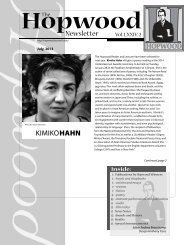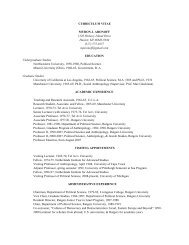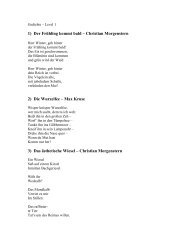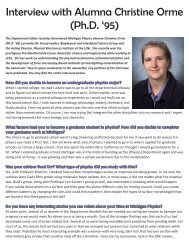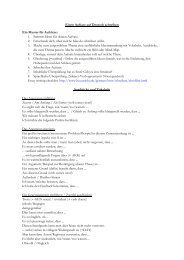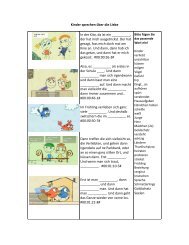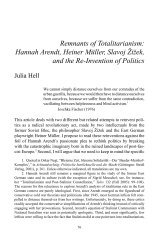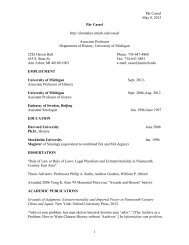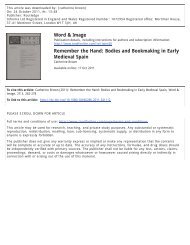newsletter - College of Literature, Science, and the Arts - University ...
newsletter - College of Literature, Science, and the Arts - University ...
newsletter - College of Literature, Science, and the Arts - University ...
You also want an ePaper? Increase the reach of your titles
YUMPU automatically turns print PDFs into web optimized ePapers that Google loves.
Vol. 5, Fall 2006<br />
<strong>University</strong> <strong>of</strong> Michigan MUSEUM OF ANTHROPOLOGY<br />
UMMA Around <strong>the</strong> Globe:<br />
International Collaborations<br />
UMMA<br />
NEWSLETTER<br />
Since <strong>the</strong> founding <strong>of</strong> <strong>the</strong> Museum <strong>of</strong> Anthropology in <strong>the</strong> 1920s, our curators have been actively engaged in<br />
archaeological research in many regions <strong>of</strong> <strong>the</strong> world, directing projects that spanned from <strong>the</strong> Philippines to<br />
<strong>the</strong> Middle East <strong>and</strong> Latin America. This expansive focus continues today as international fieldwork is increasingly<br />
constructed through formal collaborations with foreign researchers <strong>and</strong> institutions in <strong>the</strong> host country. Today’s<br />
international research is committed both to <strong>the</strong> acquisition <strong>of</strong> scientific knowledge about <strong>the</strong> past <strong>and</strong> to giving back to<br />
<strong>the</strong> inhabitants <strong>of</strong> <strong>the</strong> countries in which we work—through contributing to <strong>the</strong> training <strong>and</strong> education <strong>of</strong> future generations<br />
<strong>of</strong> archaeologists; constructing museum exhibits, educational materials, <strong>and</strong> project websites to disseminate<br />
archaeological knowledge to diverse audiences; <strong>and</strong> assisting in developing long-term curation facilities <strong>and</strong> plans<br />
for <strong>the</strong> materials our research recovers. Increasingly, <strong>and</strong> promisingly, international collaborative efforts also involve<br />
non-U.S. researchers traveling to <strong>the</strong> United States for research as well as training. Here we describe a small number<br />
<strong>of</strong> <strong>the</strong> international collaborations UMMA curators are currently involved in.<br />
In Romania, curator John O’Shea is<br />
co-directing a multiyear collaborative<br />
project with Dr. Florin Draşovean <strong>of</strong> <strong>the</strong><br />
Museum Banatului Timişoara, Dr. Peter<br />
Huegel <strong>of</strong> <strong>the</strong> Museum Judeţean Arad,<br />
<strong>and</strong> <strong>University</strong> <strong>of</strong> Michigan alumnus Dr.<br />
Alex Barker (<strong>University</strong> <strong>of</strong> Missouri).<br />
Initiated in 2003, this project focuses on<br />
<strong>the</strong> important Bronze Age site <strong>of</strong> Pecica<br />
“Şanţul Mare” <strong>and</strong> explores <strong>the</strong> social <strong>and</strong><br />
economic changes that occurred during<br />
<strong>the</strong> course <strong>of</strong> <strong>the</strong> Bronze Age. Pecica was<br />
a major center for bronze manufacturing<br />
throughout <strong>the</strong> Bronze Age <strong>and</strong> occupies<br />
a strategic location astride <strong>the</strong> river Mureş<br />
between <strong>the</strong> ore-producing region <strong>of</strong> <strong>the</strong><br />
Western Carpathian Mountains <strong>and</strong> <strong>the</strong><br />
metal-using societies <strong>of</strong> <strong>the</strong> Carpathian<br />
Basin <strong>and</strong> beyond. The 2006 field season<br />
involved opening a large block excava-<br />
tion to investigate <strong>the</strong> final Late Bronze<br />
Age occupation <strong>of</strong> <strong>the</strong> settlement <strong>and</strong> <strong>the</strong><br />
circumstances under which <strong>the</strong> site was<br />
ab<strong>and</strong>oned. Michigan doctoral students<br />
Amy Nicodemus <strong>and</strong> Paul Duffy <strong>and</strong> undergraduates<br />
Stephanie Salwen <strong>and</strong> Tyler<br />
Carter participated in this summer’s excavations.<br />
O<strong>the</strong>r European collaborations include<br />
curator Bob Whallon’s ongoing research<br />
at <strong>the</strong> Middle to Upper Paleolithic cave<br />
site <strong>of</strong> Crvena Stijena in Montenegro, a<br />
collaborative project <strong>of</strong> <strong>the</strong> <strong>University</strong> <strong>of</strong><br />
Michigan, <strong>the</strong> Center for Archaeological<br />
Investigations <strong>of</strong> Montenegro (CZAICG),<br />
<strong>and</strong> <strong>the</strong> National Heritage Museum <strong>of</strong><br />
Niksic, Montenegro.<br />
Curator Carla M. Sinopoli is collaborating<br />
with Kathleen D. Morrison (<strong>University</strong><br />
<strong>of</strong> Chicago) <strong>and</strong> <strong>the</strong> Karnataka<br />
Department <strong>of</strong> Archaeology <strong>and</strong> Museums<br />
in <strong>the</strong> “Early Historic L<strong>and</strong>scapes <strong>of</strong> <strong>the</strong><br />
Tungabhadra Corridor” project, focused<br />
on exploring <strong>the</strong> formation <strong>and</strong> nature <strong>of</strong><br />
institutionalized social inequality <strong>and</strong> territorial<br />
polities in <strong>the</strong> first millennium BC<br />
in South India. Research since 2003 has<br />
focused on <strong>the</strong> ca. sixty-hectare settlement<br />
<strong>and</strong> mortuary site <strong>of</strong> Kadebakele, where<br />
households <strong>and</strong> commemorative features<br />
have been excavated. Students from Delhi<br />
<strong>and</strong> Kerala have joined American students<br />
<strong>and</strong> project staff in excavations <strong>and</strong> laboratory<br />
analysis. O<strong>the</strong>r project members<br />
include archaeometallurgist Dr. Sharada<br />
Srinivasan from <strong>the</strong> Bangalore Institute <strong>of</strong><br />
<strong>Science</strong>, who is studying iron technology<br />
at <strong>the</strong> site, <strong>and</strong> Dr. Kajal Shah from MS<br />
<strong>University</strong> in Baroda, who is conducting<br />
petrographic analysis <strong>of</strong> ceramics. Team<br />
members are working to develop bilingual<br />
Kannada-English museum exhibits<br />
on <strong>the</strong>ir work, which will be displayed at<br />
<strong>the</strong> Karnataka Department’s museum in<br />
nearby Hampi (medieval Vijayanagara)<br />
<strong>and</strong> in <strong>the</strong> village school at Kadebakele.
Letter from <strong>the</strong> Director<br />
I write this two days after an eventful election day, as <strong>the</strong> <strong>University</strong> <strong>of</strong> Michigan begins to explore <strong>the</strong><br />
implications <strong>of</strong> <strong>the</strong> anti-affirmative action ballot initiative that has just been passed by <strong>the</strong> people <strong>of</strong> our<br />
state. In <strong>the</strong> Museum <strong>of</strong> Anthropology, whose scope is <strong>the</strong> entire world, our commitment to diversity— like that<br />
<strong>of</strong> <strong>the</strong> <strong>University</strong> <strong>of</strong> Michigan as a whole— remains strong. To quote <strong>University</strong> President Mary Sue Coleman:<br />
“. . . <strong>the</strong> <strong>University</strong> <strong>of</strong> Michigan embraces . . . promotes . . . wants . . . <strong>and</strong> believes in diversity” (http://www.<br />
umich.edu/pres/speeches/061103div.html). It is fitting <strong>the</strong>n, that in this issue <strong>of</strong> our annual <strong>newsletter</strong>, we report<br />
on <strong>the</strong> many <strong>and</strong> wide-ranging collaborative projects that Museum curators, affiliated students, <strong>and</strong> staff are<br />
engaged in—in such wide-ranging locales as Romania, Senegal, Montenegro, India, China, <strong>and</strong> with <strong>the</strong><br />
Hopi community <strong>of</strong> nor<strong>the</strong>rn Arizona. We also take this opportunity to brag on <strong>the</strong> many accomplishments <strong>of</strong><br />
our curators, staff, <strong>and</strong> affiliated graduate <strong>and</strong> undergraduate students.<br />
As I noted last year, <strong>the</strong> Museum is in a period <strong>of</strong> transition. Jeffrey Parsons <strong>of</strong>ficially retired on June 30 <strong>and</strong><br />
has been granted <strong>the</strong> rank <strong>of</strong> Curator Emeritus. Richard I. Ford will make <strong>the</strong> same transition in June 2007.<br />
Both remain active members <strong>of</strong> <strong>the</strong> Museum community. This academic year, <strong>the</strong> curators are engaging<br />
in extended discussions about our future, reaffirming our commitment to remain a first-class educational<br />
<strong>and</strong> research unit even in <strong>the</strong> face <strong>of</strong> <strong>the</strong> challenging economic situation that our state <strong>and</strong> university are<br />
currently confronting. At <strong>the</strong> same time, we continue to work to enhance our commitment to <strong>the</strong> incredible<br />
archaeological <strong>and</strong> ethnographic collections entrusted to our care. In summer 2006, with funding from<br />
<strong>the</strong> Institute for Museums <strong>and</strong> Library Services, we conducted a “Conservation Assessment Survey” <strong>of</strong> <strong>the</strong><br />
Museum’s three collection spaces. We are now digesting <strong>the</strong> daunting results <strong>of</strong> that report, to develop longterm<br />
strategies for improving collection care <strong>and</strong> accessibility. This will, <strong>of</strong> course, require resources <strong>and</strong> we will<br />
no doubt be coming to you, our long-time friends <strong>and</strong> supporters, to ask for your continued assistance. Today,<br />
though, I merely thank you for your friendship to <strong>the</strong> Museum <strong>and</strong> invite you to enjoy this brief report on a<br />
small subset <strong>of</strong> our ongoing activities.<br />
Carla M. Sinopoli<br />
November 9, 2006<br />
International Collaborations cont.<br />
Curator Henry Wright spent part <strong>of</strong> <strong>the</strong> summer<br />
in 2006 in China engaged in three collaborative<br />
efforts. He taught in a summer school<br />
program on Complex Systems, contributing<br />
lectures on efforts to model cultural evolution.<br />
Sponsored by <strong>the</strong> Santa Fe Institute <strong>and</strong> held in<br />
Beijing, <strong>the</strong> program involved 52 students: 31<br />
from China <strong>and</strong> 21 from o<strong>the</strong>r countries including<br />
Argentina, Chile, Brazil, Mexico, <strong>the</strong> U.S.,<br />
Canada, Spain, Italy, Germany, <strong>the</strong> Ne<strong>the</strong>rl<strong>and</strong>s,<br />
Bulgaria, Iran, India, <strong>and</strong> Australia. Henry <strong>the</strong>n<br />
headed to Luoyang in <strong>the</strong> Yi-Luo River Valley<br />
to meet with his colleagues from <strong>the</strong> Yi-Luo archaeological<br />
survey project—Pr<strong>of</strong>. Chen Xingcan<br />
(Institute <strong>of</strong> Archaeology, Beijing), Liu Li<br />
(La Trobe <strong>University</strong>, Melbourne, Australia), <strong>and</strong><br />
Lee Yunkuen (Harvard <strong>University</strong>)—to begin<br />
preparing <strong>the</strong> publication on <strong>the</strong> results <strong>of</strong> <strong>the</strong>ir<br />
multiyear archaeological survey focused on <strong>the</strong><br />
region surrounding <strong>the</strong> site <strong>of</strong> Erlitou, <strong>the</strong> earliest<br />
state center in China. Before leaving China,<br />
Henry went on to Jinan in Sh<strong>and</strong>ong province to<br />
visit UM doctoral student Li Min <strong>and</strong> to begin<br />
discussions on a future collaborative project with<br />
archaeologists from Sh<strong>and</strong>ong <strong>University</strong>.<br />
Curators Joyce Marcus <strong>and</strong> Kent V. Flannery<br />
remain engaged in collaborative research with<br />
scholars from Mexico <strong>and</strong> Peru. In Mexico, <strong>the</strong>y<br />
are collaborating with Dra. María de los Angeles<br />
Romero Frizzi <strong>and</strong> Dr. Manuel Esparza <strong>of</strong> <strong>the</strong><br />
Centro Regional de Oaxaca <strong>and</strong> with Dr. Ernesto<br />
González Licán (Museo Nacional de Antropología).<br />
Their Peruvian colleagues include Dr.<br />
UMMA Newsletter — Fall, 2006<br />
Richard I. Ford <strong>and</strong> UM alum Hea<strong>the</strong>r Trigg with members <strong>of</strong> <strong>the</strong> Oman Cultural Heritage Foundation.<br />
Ramiro Matos (Universidad Nacional Mayor de<br />
San Marcos), Dr. Duccio Bonavia (Universidad<br />
Cayetano Heredia), Dra. María Rostoworowski<br />
de Diez Canseco (Instituto de Estudios Peruanos),<br />
<strong>and</strong> Dr. Jorge Silva (Universidad Ricard<br />
Palma <strong>and</strong> Universidad Nacional Mayor de San<br />
Marcos).<br />
Within <strong>the</strong> U.S., curator Richard Ford hosted<br />
Dr. Su Sheng, head <strong>of</strong> <strong>the</strong> China Rock Art Society,<br />
in a tour <strong>of</strong> rock art sites in nor<strong>the</strong>rn New<br />
Mexico. Ford also met with members <strong>of</strong> <strong>the</strong><br />
Oman Cultural Heritage Preservation team who<br />
visited New Mexico last summer to discuss a<br />
range <strong>of</strong> issues concerning <strong>the</strong> preservation <strong>of</strong><br />
archaeological heritage.<br />
UMMA Archaeological Field Schools<br />
In 2006, Museum researchers sponsored three archaeological field<br />
schools, <strong>of</strong>fered in concert with <strong>the</strong> Department <strong>of</strong> Anthropology.<br />
Excavation at <strong>the</strong> Michigan Biological Field School.<br />
Closest to home, Museum affiliate <strong>and</strong> recent anthropology PhD Meghan Howey<br />
directed a field project excavating Late Woodl<strong>and</strong> sites along Douglas Lake in northcentral<br />
Michigan, in collaboration with <strong>the</strong> <strong>University</strong> <strong>of</strong> Michigan Biological Station.<br />
This project marks <strong>the</strong> start <strong>of</strong> an exciting new collaboration between <strong>the</strong> Museum<br />
<strong>and</strong> <strong>the</strong> <strong>University</strong>’s Biological Station, long a leader in environmental <strong>and</strong> ecological<br />
research <strong>and</strong> teaching in <strong>the</strong> Great Lakes. Fourteen undergraduate students from<br />
three different universities <strong>and</strong> colleges participated in <strong>the</strong> project with project staff<br />
Stephanie Salwen, Bethany Dykstra, <strong>and</strong> Uthara Suvrathan. Excavations in 2006 focused<br />
on site 20CN63, a late prehistoric settlement dating to ca. AD 1200-1600. Dense<br />
cultural materials, including several features, were identified. Artifacts, currently being<br />
analyzed in <strong>the</strong> Museum’s Great Lakes Range, included abundant lithic debris,<br />
including numerous projectile points, <strong>the</strong> remains <strong>of</strong> several complete ceramic vessels,<br />
copper tools, <strong>and</strong> a large stone axe. Students kept an active class blog, which you can<br />
read at http://mblog.lib.umich.edu/archmi/.<br />
In June <strong>and</strong> July, 2006, Museum Research Scientist Lisa C. Young directed <strong>the</strong> first season <strong>of</strong> a three-year research project examining changes<br />
in twelfth- <strong>and</strong> early thirteenth-century communities in <strong>the</strong> Homol’ovi area near Winslow, Arizona. This area is best known for its ancestral<br />
Hopi villages—large pueblos first inhabited during <strong>the</strong> second half <strong>of</strong> <strong>the</strong> thirteenth century—but little is known about village life prior to AD 1250.<br />
Lisa’s team focused on this early period in <strong>the</strong>ir research at Cresswell Pueblo, <strong>the</strong> first known pueblo site in <strong>the</strong> area. Along with Dr. Young, project<br />
members <strong>of</strong> <strong>the</strong> Homol’ovi Undergraduate Research Opportunities Program (HUROP)<br />
included fourteen undergraduate students from all over <strong>the</strong> U.S. (including Claire Barker,<br />
Sarah Hasho, <strong>and</strong> Ben Shepherd from UM) <strong>and</strong> four UM doctoral students (Hemanth<br />
Kadambi, Matt Kroot, <strong>and</strong> Khori Newl<strong>and</strong>er from Anthropology <strong>and</strong> John Low from<br />
American Culture <strong>and</strong> <strong>the</strong> <strong>University</strong>’s Museum Studies Program). Funded by <strong>the</strong><br />
National <strong>Science</strong> Foundation’s Undergraduate Research Experience for Undergraduates<br />
Program, HUROP integrates archaeological research with public outreach to teach<br />
students <strong>the</strong> methods <strong>and</strong> processes involved in archaeological fieldwork <strong>and</strong> <strong>the</strong> skills<br />
necessary to communicate information about scientific research in a meaningful way<br />
to <strong>the</strong> general public. The integration <strong>of</strong> archaeology with public outreach creates a<br />
dynamic environment in which students learn about scientific research <strong>and</strong>, in turn,<br />
share what <strong>the</strong>y have learned with <strong>the</strong> public. During <strong>the</strong> summer <strong>of</strong> 2006, participants<br />
conducted independent research projects that were integrated into public outreach<br />
displays at <strong>the</strong> Homol’ovi Ruins State Park. Dr. Ray Silverman, <strong>the</strong> director <strong>of</strong> <strong>the</strong><br />
UM Museum Studies Program, <strong>and</strong> Ms. Susan Secakuku, <strong>of</strong> <strong>the</strong> Hopi Tribe, serve as<br />
faculty mentors on <strong>the</strong> project. Excavated materials were brought to Ann Arbor for<br />
analysis. This semester, <strong>the</strong> three UM field school participants have been joined in <strong>the</strong><br />
laboratory by undergraduates Nicole Bork, Caitlin Bumford, Maia Dedrick, <strong>and</strong> Meg<br />
Nisch; <strong>the</strong>y are working in <strong>the</strong> North American archaeology division to process <strong>and</strong><br />
analyze <strong>the</strong> artifacts recovered from Creswell Pueblo.<br />
HUROP Team.<br />
Find us on <strong>the</strong> Web at www.lsa.umich.edu/umma 2 - 3 -<br />
Find us on <strong>the</strong> Web at www.lsa.umich.edu/umma<br />
Four UM undergraduates (Tamika Baldwin, Jill Krick,<br />
Isaac Jalkanen, <strong>and</strong> Alex<strong>and</strong>ra Morley) participated in <strong>the</strong><br />
Sine Ngayene Archaeological Project in Senegal, directed by<br />
curator Augustin Holl <strong>and</strong> assisted by UM doctoral student<br />
Cameron Gokee <strong>and</strong> Abdoulaye Kane (<strong>University</strong> Cheikh<br />
Anta Diop, Dhakar). Excavations were conducted at <strong>the</strong> site <strong>of</strong><br />
Ngayene-II, an Iron Age cemetery containing numerous megalithic<br />
stone circles, ear<strong>the</strong>n tumuli <strong>and</strong> a possible ritual space.<br />
In summer 2006, <strong>the</strong> team excavated four megaliths containing<br />
<strong>the</strong> remains <strong>of</strong> numerous primary <strong>and</strong> secondary burials,<br />
as well as ceramics, iron spear points, <strong>and</strong> copper ornaments.<br />
The most recent feature also contained a historic clay tobacco<br />
pipe <strong>and</strong> worked glass. A portion <strong>of</strong> <strong>the</strong> materials excavated<br />
have been accessioned into <strong>the</strong> permanent collections <strong>of</strong> <strong>the</strong><br />
Museum’s African Archaeology Division. In fall 2006, undergraduate<br />
students Julie Miner, Alex Kastl, Laura Misumi, Shaeli<br />
Bowers, <strong>and</strong> Eric Dryer are working to analyze <strong>and</strong> catalogue<br />
<strong>the</strong>se materials as participants in <strong>the</strong> <strong>University</strong>’s Undergraduate<br />
Research Opportunities Program (UROP).<br />
Laboratory at UM Senegal Field Station.<br />
UMMA Newsletter — Fall, 2006
Excavations at Cresswell Pueblo in<br />
<strong>the</strong> Homol’ovi area near Winslow,<br />
Arizona. As part <strong>of</strong> <strong>the</strong> 2006 summer<br />
field school, students joined project<br />
director Lisa C. Young <strong>and</strong> doctoral<br />
students Khori Newl<strong>and</strong>er, Matt Kroot,<br />
<strong>and</strong> Hemanth Kadambi in excavating<br />
this early pueblo (see p. 3).<br />
Snapshots from <strong>the</strong> field...<br />
Under curator John O’Shea, <strong>the</strong> Great Lakes<br />
Range’s program in nautical archaeology was<br />
again active in Lake Huron. Senior, now graduate,<br />
Brad Krueger continued his work preparing<br />
plan drawings for a wreck in <strong>the</strong> vicinity <strong>of</strong> Drummond<br />
Isl<strong>and</strong>, while undergraduate students<br />
Stephanie Salwen, Steve Gates, <strong>and</strong> Tyler Carter<br />
(shown here) are pursuing honors <strong>the</strong>sis projects<br />
on wrecks in western Lake Huron.<br />
Doctoral student Allison Davis is spending <strong>the</strong> year in Peru as a<br />
Fulbright IIE Scholar excavating <strong>the</strong> early village settlement <strong>of</strong><br />
Yuthu (500 BC-AD 200) in <strong>the</strong> Cuzco region. Her project seeks to<br />
explore <strong>the</strong> beginnings <strong>of</strong> sedentary life in <strong>the</strong> region.<br />
With <strong>the</strong> participation <strong>of</strong> local Peruvian archaeologists, Véronique Bélisle<br />
conducted preliminary excavations at <strong>the</strong> site <strong>of</strong> Ak’awillay in <strong>the</strong> Cuzco region<br />
<strong>of</strong> sou<strong>the</strong>rn Peru. She discovered <strong>the</strong> remains <strong>of</strong> an ancient house containing<br />
hearths, ceramic fragments, animal bones, bone <strong>and</strong> stone tools,<br />
<strong>and</strong> a human burial. This pilot project will be followed by more excavations<br />
that will allow Véronique to study <strong>the</strong> impact <strong>of</strong> <strong>the</strong> Wari Empire’s expansion<br />
(AD 600-1000) on a local village.<br />
Curator Henry Wright <strong>and</strong> doctoral students Matt Kroot,<br />
Amy Nicodemus, <strong>and</strong> Margaret Wilson joined Dr. Rick Zurel<br />
(Schoolcraft <strong>College</strong>) <strong>and</strong> o<strong>the</strong>r volunteers to search for<br />
<strong>the</strong> Grogitsky site, a rare <strong>and</strong> unique Paleoindian camp<br />
site in Michigan’s Monroe County, originally discovered by<br />
an amateur who never revealed its location.<br />
Doctoral student Stephen<br />
Dueppen completed his NSFsupported<br />
dissertation fieldwork<br />
exploring <strong>the</strong> origins<br />
<strong>and</strong> development <strong>of</strong> <strong>the</strong> Iron<br />
Age village <strong>of</strong> Kirikongo near<br />
<strong>the</strong> Mouhoun River, Burkina<br />
Faso. Dueppen gave a tour<br />
<strong>of</strong> <strong>the</strong> site <strong>and</strong> explained<br />
his research to Jeanine<br />
Jackson, U.S. Ambassador<br />
to Burkina Faso, <strong>and</strong> o<strong>the</strong>r<br />
embassy employees.<br />
Doctoral student Daphne<br />
Gallagher recorded 500 sites<br />
during her NSF-supported full<br />
coverage survey <strong>of</strong> a drainage<br />
near <strong>the</strong> Gobnangou escarpment<br />
in sou<strong>the</strong>astern Burkina<br />
Faso. Her research creates <strong>the</strong><br />
first chronology for <strong>the</strong> region<br />
as its explores <strong>the</strong> adoption<br />
<strong>of</strong> agricultural economies by<br />
prehistoric communities.<br />
John O’Shea continued NSF-supported<br />
excavations at <strong>the</strong> European Bronze<br />
Age settlement <strong>of</strong> Pecica “Şanţul Mare”<br />
in Romania. In summer 2006, graduate<br />
students Amy Nicodemus <strong>and</strong> Paul<br />
Duffy <strong>and</strong> undergraduates Stephanie<br />
Salwen <strong>and</strong> Tyler Carter joined O’Shea<br />
<strong>and</strong> his collaborators in <strong>the</strong> excavations<br />
(see p. 1).<br />
Curator Henry Wright continued<br />
survey around <strong>the</strong> Bronze Age<br />
settlement <strong>of</strong> Tell Brak in Syria.<br />
Graduate student Am<strong>and</strong>a<br />
Logan participated in <strong>the</strong><br />
Gulo-Makeda Archaeological<br />
Project in nor<strong>the</strong>rn Ethiopia.<br />
This project, directed<br />
by Dr. Ca<strong>the</strong>rine D’Andrea<br />
<strong>of</strong> Simon Fraser <strong>University</strong>,<br />
includes ethnobotanical<br />
research, archaeological<br />
survey focused on documenting<br />
rural communities<br />
around <strong>the</strong> ancient urban<br />
center <strong>of</strong> Aksum, <strong>and</strong> archaeobotanical<br />
research<br />
on excavated materials<br />
from Aksum.<br />
Curator Carla M. Sinopoli<br />
<strong>and</strong> doctoral student Matt<br />
Gallon traveled to South<br />
India to continue analyzing<br />
ceramics <strong>and</strong> lithics from<br />
excavations at <strong>the</strong> Iron Age<br />
community <strong>of</strong> Kadebakele,<br />
<strong>and</strong> visited major sites in Sri<br />
Lanka as guests <strong>of</strong> archaeologists<br />
Sirin Deraniyagala<br />
<strong>and</strong> Sudarshan Senivratne<br />
(see p. 1).<br />
Amy Nicodemus spent <strong>the</strong> first half <strong>of</strong> <strong>the</strong> summer<br />
in Hungary, analyzing faunal remains from 3 Bronze<br />
Age tell settlements <strong>and</strong> assisting with a regional<br />
survey for <strong>the</strong> BAKOTA project. Afterwards, she<br />
worked at <strong>the</strong> <strong>University</strong> <strong>of</strong> Michigan’s Pecica Project<br />
in Romania, excavating this Romanian Bronze Age<br />
tell <strong>and</strong> analyzing <strong>the</strong> season’s faunal assemblage<br />
(see p. 1).<br />
Along with teaching in a<br />
complex systems summer<br />
school in Beijing, curator<br />
Henry Wright worked<br />
with his collaborators in<br />
<strong>the</strong> Yi-Luo survey project<br />
to revisit sites <strong>and</strong> refine<br />
publication plans for a<br />
monograph reporting on<br />
<strong>the</strong> 222 sites <strong>the</strong> team<br />
identified along <strong>the</strong><br />
Yi-Luo River in <strong>the</strong>ir 1997-<br />
2002 fieldwork (see p. 2).<br />
Li Min returned to<br />
China to continue<br />
analyzing faunal<br />
remains <strong>and</strong> ceramics<br />
from his<br />
2005 excavation at<br />
<strong>the</strong> site <strong>of</strong> Daxinzhuang,<br />
a Bronze<br />
Age city dating to<br />
<strong>the</strong> late 2nd millennium BC in eastern<br />
China. His research focuses on<br />
ways in which material, social <strong>and</strong><br />
cultural worlds converge in <strong>the</strong><br />
human interaction with animals<br />
at <strong>the</strong> site, particularly in food use<br />
<strong>and</strong> ritual performance. Min also<br />
assisted his co-director in <strong>the</strong> City<br />
Institute <strong>of</strong> Archaeology on urban<br />
excavations with his knowledge <strong>of</strong><br />
historical ceramics, gained from<br />
working on <strong>the</strong> extensive collections<br />
in <strong>the</strong> Asian Range.
Museum Image Database Completed<br />
After five years <strong>of</strong> hard work, <strong>the</strong> UMMA<br />
has finished scanning <strong>the</strong> teaching slides <strong>and</strong> <strong>the</strong><br />
James B. Griffin Slide Collection: nearly 27,000<br />
total images. Detailed information on each slide<br />
is provided in a searchable Micros<strong>of</strong>t Access<br />
database. Both <strong>the</strong> images <strong>and</strong> <strong>the</strong> database information<br />
are available to researchers <strong>and</strong> <strong>the</strong><br />
general public through <strong>the</strong> Museum <strong>of</strong> Anthropology’s<br />
website. Please visit us at http://www.<br />
lsa.umich.edu/umma/ <strong>and</strong> click <strong>the</strong> On-Line<br />
Catalog link to search for <strong>and</strong> view images.<br />
The image database project was supervised<br />
by Museum collection manager Karen O’Brien,<br />
New Collections<br />
The Museum has accessioned 21 new collections<br />
thus far in 2006. These include collections<br />
from <strong>the</strong> Museum’s archaeological field schools<br />
in Michigan <strong>and</strong> Senegal, as well as donated<br />
collections from Arizona, China, Michigan, <strong>and</strong><br />
Syria, <strong>and</strong> comparative faunal specimens for<br />
<strong>the</strong> zooarchaeological laboratory. Pr<strong>of</strong>essor Ray<br />
Silverman, director <strong>of</strong> <strong>the</strong> <strong>University</strong>’s Museum<br />
Studies Program, spent part <strong>of</strong> <strong>the</strong> summer in<br />
Ghana working with traditional lost wax bronze<br />
casters. This important art, once focused on <strong>the</strong><br />
production <strong>of</strong> elite objects for Ghananian royalty,<br />
has now exp<strong>and</strong>ed to serve contemporary craft<br />
<strong>and</strong> tourist markets. The collection <strong>of</strong> more than<br />
50 objects <strong>and</strong> associated documentary material<br />
on <strong>the</strong> artists <strong>and</strong> <strong>the</strong>ir technology was accessioned<br />
into <strong>the</strong> Museum’s ethnology division.<br />
Katalin Biró<br />
In fall 2006, <strong>the</strong> Museum is hosting visiting<br />
scholar Katalin T. Biró, Senior Research Fellow in<br />
<strong>the</strong> Department <strong>of</strong> Archaeology at <strong>the</strong> Hungarian<br />
National Museum in Budapest. Dr. Biró’s visit is<br />
supported by <strong>the</strong> Fulbright Visiting Scholar program.<br />
Dr. Biró’s research focuses on <strong>the</strong> study<br />
<strong>of</strong> prehistoric trade in Central <strong>and</strong> Eastern Europe,<br />
through <strong>the</strong> use <strong>of</strong> diverse methods <strong>of</strong><br />
lithic raw material sourcing. She is also active<br />
in <strong>the</strong> arena <strong>of</strong> informatics <strong>and</strong> in <strong>the</strong> application<br />
<strong>of</strong> quantitative techniques to archaeological<br />
data, <strong>and</strong> serves on several international committees<br />
focused on <strong>the</strong>se issues. While in Ann<br />
Arbor, Dr. Biró is teaching a seminar on “tracing<br />
<strong>the</strong> long-distance movement <strong>of</strong> resources.”<br />
She is also participating in several courses <strong>and</strong> is<br />
working closely with curators John O’Shea <strong>and</strong><br />
Bob Whallon <strong>and</strong> graduate students focusing on<br />
European prehistory.<br />
UMMA Newsletter — Fall, 2006<br />
<strong>and</strong> was carried out by Erica Beebe, Amy<br />
Lawson, Patrick Livingood, Julie Solometo,<br />
Margaret Prest, Hallie Jones, Brad Krueger,<br />
Jessica Meulendyk, John Weise, Michelle<br />
Sweeter, <strong>and</strong> Liz Konzak. Funding for <strong>the</strong><br />
work came from <strong>the</strong> UM <strong>College</strong> <strong>of</strong> <strong>Literature</strong>,<br />
<strong>Science</strong> <strong>and</strong> <strong>Arts</strong> <strong>and</strong> <strong>the</strong> National Endowment<br />
for Humanities Division <strong>of</strong> Preservation<br />
<strong>and</strong> Access.<br />
With continued LSA support, our slide digitization<br />
efforts continue this year, focused on<br />
several thous<strong>and</strong> images donated to <strong>the</strong> Museum<br />
by curator Richard I. Ford.<br />
Photos by R. Silverman.<br />
Katalin T. Biró<br />
PhDs in Anthropological<br />
Archaeology in 2005-2006<br />
Bernice Sunday Eiselt: The Emergence <strong>of</strong> Jicarilla<br />
Apace Enclave Economy during <strong>the</strong><br />
Nineteenth Century in Nor<strong>the</strong>rn New Mexico,<br />
December 2005.<br />
Sigrid Gabler: Iron Furnaces <strong>and</strong> Future Kings:<br />
Craft Specialization <strong>and</strong> <strong>the</strong> Emergence <strong>of</strong> Political<br />
Power in Central Madagascar, June 2005.<br />
Meghan Howey: Ritual, Resources, <strong>and</strong> Regional<br />
Organization in <strong>the</strong> Upper Great Lakes,<br />
A.D. 1200-1600, April 2006.<br />
Patrick Livingood: Archaeological Investigations<br />
<strong>of</strong> a Mississippian Polity on <strong>the</strong> Middle<br />
Pearl River, Mississippi, May 2006.<br />
Tineke Van Z<strong>and</strong>t: Shaping Stones <strong>and</strong> Shaping<br />
Pueblos: Architecture, Site Layout <strong>and</strong> Settlement<br />
in B<strong>and</strong>elier National Monument, New<br />
Mexico, December 2005.<br />
New in 2006 from<br />
Museum <strong>of</strong> Anthropology<br />
Publications<br />
West African Early Towns: Archaeology <strong>of</strong><br />
Households in Urban L<strong>and</strong>scapes<br />
(Anthro. Papers, 95) by Augustin F.C. Holl<br />
The Last Pescadores <strong>of</strong> Chimalhuacán,<br />
Mexico: An Archaeological Ethnography,<br />
(Anthro. Papers, 96) by Jeffrey R. Parsons<br />
Coming soon . . . An Archaeological Survey<br />
<strong>of</strong> Avaradrano: The Heartl<strong>and</strong> <strong>of</strong> <strong>the</strong> Early<br />
State Formation in Central Madagascar,<br />
(Memoir 41), edited by Henry T. Wright<br />
To order <strong>the</strong>se <strong>and</strong> o<strong>the</strong>r UMMA publications<br />
see our website at www.lsa.umich.<br />
edu/umma <strong>and</strong> click on Publications. Or<br />
email umma-pubs@umich.edu.<br />
Select Curator Accomplishments <strong>and</strong> Awards<br />
Kent V. Flannery published <strong>the</strong> Prefatory chapter<br />
in <strong>the</strong> 2006 Annual Review <strong>of</strong> Anthropology<br />
(35:1-13). Entitled “On <strong>the</strong> Resilience <strong>of</strong><br />
Anthropological Archaeology,” it provides<br />
a retrospective view <strong>of</strong> <strong>the</strong> last 40 years <strong>of</strong><br />
anthropological archaeology.<br />
Richard I. Ford<br />
Richard I. Ford received <strong>the</strong> Franz Boas Award<br />
for Exemplary Service to Anthropology from<br />
<strong>the</strong> American Anthropological Association.<br />
This award is given annually in recognition <strong>of</strong><br />
an AAA member’s outst<strong>and</strong>ing contribution<br />
to anthropology through <strong>the</strong> increase <strong>and</strong><br />
dissemination <strong>of</strong> humanistic <strong>and</strong> scientific<br />
knowledge <strong>and</strong> service to <strong>the</strong> pr<strong>of</strong>ession.<br />
Augustin Holl published West African Early<br />
Towns: Archaeology <strong>of</strong> Households in Urban<br />
L<strong>and</strong>scapes (2006, UMMA Anthropological<br />
Papers) <strong>and</strong> was co-author <strong>of</strong> four articles in<br />
<strong>the</strong> New York Burial Ground, Final Report <strong>and</strong><br />
<strong>the</strong> article “New Perspectives on <strong>the</strong> Diwan” in<br />
L<strong>and</strong>, Literacy <strong>and</strong> <strong>the</strong> State in Sudanic Africa<br />
(ed. D. Crumney, Red Sea Press).<br />
Along with serving as Associate Chair <strong>of</strong> <strong>the</strong><br />
Department <strong>of</strong> Anthropology, Joyce Marcus<br />
serves as chair <strong>of</strong> <strong>the</strong> Social <strong>Science</strong> Committee<br />
for Demography, Anthropology <strong>and</strong> Geography<br />
in <strong>the</strong> American Academy <strong>of</strong> <strong>Science</strong>s, <strong>and</strong> as <strong>the</strong><br />
Head <strong>of</strong> Anthropology in <strong>the</strong> National Academy<br />
<strong>of</strong> <strong>Science</strong>s. Agricultural Strategies, co-edited<br />
by Joyce Marcus <strong>and</strong> Charles E. Stanish (Cotsen<br />
Institute, UCLA), appeared in 2006, along with<br />
several articles on Mesoamerican archaeology.<br />
John O’Shea was awarded an NSF grant for<br />
his ongoing field research at Pecica in Hungary<br />
<strong>and</strong> continues to conduct research on historic<br />
shipwrecks in Lake Huron, Michigan. With<br />
recent UM PhD Meghan Howey, O’Shea<br />
published an article in <strong>the</strong> spring 2006 issue <strong>of</strong><br />
American Antiquity (vol. 71, no. 2).<br />
Carla M. Sinopoli will be <strong>the</strong> keynote speaker at<br />
<strong>the</strong> conference “Royal Legacy: Vijayanagara to<br />
Mysore” at <strong>the</strong> Museum <strong>of</strong> Fine <strong>Arts</strong>, Houston, in<br />
December 2006. An article on Gu<strong>the</strong> Collection<br />
ceramics appeared in <strong>the</strong> fall 2006 issue <strong>of</strong> Asian<br />
Perspectives; nine long in-press articles on<br />
Volunteers WE THANK OUR 2005-2006 DONORS<br />
Volunteers make crucial contributions to many<br />
<strong>of</strong> <strong>the</strong> museum’s activities, cataloguing <strong>and</strong><br />
documenting collections <strong>and</strong> assisting curators<br />
<strong>and</strong> doctoral students in analyses <strong>of</strong> archaeological<br />
materials. These volunteers come from <strong>the</strong><br />
UM student community as well as <strong>the</strong> larger<br />
sou<strong>the</strong>astern Michigan community. Alisa English<br />
(shown here) has been volunteering in <strong>the</strong> Museum<br />
since 2002 <strong>and</strong> is currently assisting in our efforts<br />
to inventory <strong>the</strong> archaeobotany collections. If<br />
you are interested in volunteering, please contact<br />
Karen O’Brien (klobrien@umich.edu).<br />
John Alden<br />
David Anderson<br />
Jeanne Arnold<br />
Robert Brubaker<br />
Jan Carline<br />
Robert Carneiro<br />
Charles Clel<strong>and</strong><br />
Colette Conrad Atkins<br />
C. Wesley Cowan<br />
Suzanne DeSarbo<br />
William Doelle<br />
Penelope Drooker<br />
Robert Dunnell<br />
John Eaton<br />
Christina Elson<br />
Gary Feinman<br />
Kent Flannery<br />
Nathaniel & Mary Ford<br />
Richard & Karen Ford<br />
Carol Gol<strong>and</strong><br />
Larry Gorenflo<br />
William Griffin<br />
Charles Hastings<br />
Fredrik Hiebert<br />
Augustin Holl<br />
William Jaffee<br />
Arthur Jelinek<br />
Stephanie Kulow<br />
Peter & Sally Kunstadter<br />
Lewis Larson, Jr.<br />
David Mackres<br />
Bruce Mannheim<br />
Joyce Marcus<br />
Ellen Messer<br />
Naomi Miller<br />
Preston Miracle<br />
Hattula Moholy-Nagy<br />
Ka<strong>the</strong>rine Moore Hiebert<br />
Ka<strong>the</strong>rine Moynes<br />
Sarah Nelson<br />
Karen O’Brien<br />
John O’Shea<br />
William Parkinson<br />
Jeffrey Parsons<br />
Gene Peske<br />
Nanette Pyne<br />
Alison Rautman<br />
Richard Redding, Jr.<br />
Lawrence Robbins<br />
Thomas Rocek<br />
Karen Rosenberg<br />
Martha Rolingson<br />
Mitchell Rothman<br />
Alan Ryan<br />
George Schwartz<br />
Carla Sinopoli<br />
Monica Smith<br />
Michael & Cynthia Smith<br />
Charles Spencer<br />
John Speth<br />
Ka<strong>the</strong>rine Spielmann<br />
A.T. Steegmann, Jr.<br />
Find us on <strong>the</strong> Web at www.lsa.umich.edu/umma 6 - 7 -<br />
Find us on <strong>the</strong> Web at www.lsa.umich.edu/umma<br />
<strong>the</strong> Vijayanagara Metropolitan Survey project<br />
appeared in 2006.<br />
John D. Speth was an invited speaker in a public<br />
symposium at UC-San Diego on “The Origin<br />
<strong>and</strong> Fate <strong>of</strong> Ne<strong>and</strong>erthals.” He has published<br />
two recent articles on his research in Israel, <strong>and</strong><br />
continues to work on materials from <strong>the</strong> Bloom<br />
site in sou<strong>the</strong>astern New Mexico. Speth’s Arthur<br />
F. Thurnau Pr<strong>of</strong>essorship for Undergraduate<br />
Teaching, originally awarded for three years,<br />
was extended indefinitely.<br />
Robert Whallon was co-editor with William<br />
Lovis <strong>and</strong> R<strong>and</strong>olph Donahue <strong>of</strong> a special issue<br />
<strong>of</strong> <strong>the</strong> Journal <strong>of</strong> Anthropological Archaeology on<br />
“Mesolithic Mobility, Exchange <strong>and</strong> Interaction”<br />
(vol. 25, no. 2), <strong>and</strong> was awarded a grant from<br />
<strong>the</strong> National Geographic Society for his research<br />
at Crvena Stijena in Montenegro.<br />
Henry T. Wright published “The Polycentricity<br />
<strong>of</strong> Civilizations” in A Catalyst for Ideas (ed. V.L.<br />
Scarborough, SAR Press). In 2005-2006, Wright<br />
conducted fieldwork in Madagascar, China,<br />
Syria, <strong>and</strong> Michigan.<br />
Curator C. Loring Brace accepted <strong>the</strong> Charles<br />
Darwin Lifetime Achievement Award in<br />
Physical Anthropology at <strong>the</strong> Annual Meetings<br />
<strong>of</strong> <strong>the</strong> American Association <strong>of</strong> Physical<br />
Anthropology in March 2006 in Anchorage.<br />
Loring also published two articles in 2006 <strong>and</strong><br />
has 10 publications in press.<br />
Wilma Wetterstrom<br />
Pauline Wiessner<br />
Alma Wooll<br />
Alfred Wooll<br />
Norman Y<strong>of</strong>fee<br />
Lisa Young<br />
Thanks to Mr. Pierre Berry <strong>of</strong> Baltimore,<br />
MD, for making a second generous<br />
charitable gift annuity to <strong>the</strong> Museum<br />
<strong>of</strong> Anthropology. Mr. Berry earned his<br />
MA in Anthropology in 1950 <strong>and</strong> fondly<br />
remembers working with <strong>the</strong> Museum’s<br />
collections. The gift especially<br />
acknowledges Mrs. Margaret Guta,<br />
Museum registrar in <strong>the</strong> 1940s <strong>and</strong><br />
1950s.<br />
As part <strong>of</strong> a major donation to <strong>the</strong><br />
<strong>University</strong> <strong>of</strong> Michigan, UM alumni<br />
Mr. <strong>and</strong> Mrs. Ranvir <strong>and</strong> Arvish Trehan<br />
have donated $100,000 to support <strong>the</strong><br />
archaeological research <strong>of</strong> Curator<br />
<strong>and</strong> Pr<strong>of</strong>essor Carla M. Sinopoli in India.<br />
These funds, intended to encourage<br />
current <strong>and</strong> future collaborations<br />
between U-M <strong>and</strong> India, will be used<br />
to support Michigan doctoral students<br />
working in India as well as Sinopoli’s<br />
ongoing collaborative research<br />
project in South India.<br />
For information on giving opportunities <strong>and</strong> development priorities <strong>of</strong> <strong>the</strong> Museum <strong>of</strong> Anthropology please<br />
contact Carla M. Sinopoli (sinopoli@umich.edu) or visit http://www.lsa.umich.edu/umma/support/<br />
UMMA Newsletter — Fall, 2006
The <strong>University</strong> <strong>of</strong> Michigan<br />
Museum <strong>of</strong> Anthropology<br />
4009 Museums Bldg<br />
Ann Arbor, MI 48109-1079<br />
Regents <strong>of</strong> <strong>the</strong><br />
<strong>University</strong> <strong>of</strong> Michigan<br />
David A. Br<strong>and</strong>on<br />
Laurence B. Deitch<br />
Olivia P. Maynard<br />
Rebecca McGowan<br />
Andrea Fischer Newman<br />
Andrew C. Richner<br />
S. Martin Taylor<br />
Ka<strong>the</strong>rine E. White<br />
Mary Sue Coleman (ex <strong>of</strong>ficio)<br />
<strong>University</strong> <strong>of</strong> Michigan<br />
Museum <strong>of</strong> Anthropology<br />
Great Lakes Division<br />
Pot, Bussinger Site, ca. 1000 AD<br />
UMMA 17390



